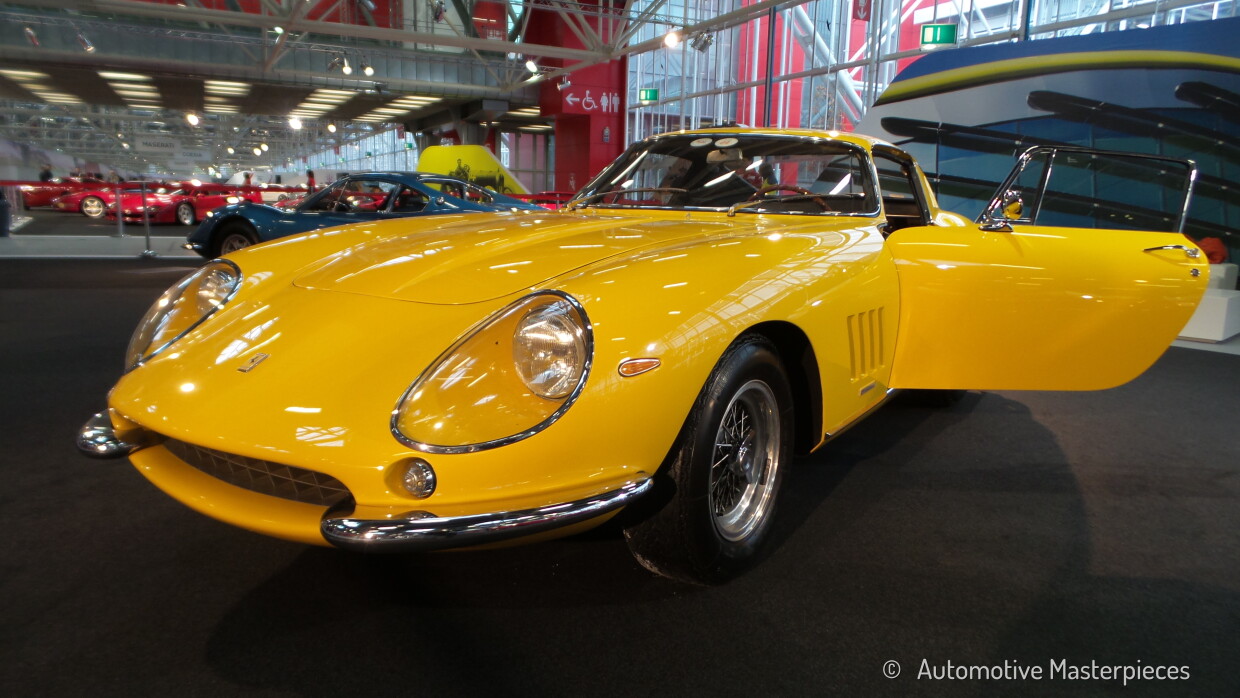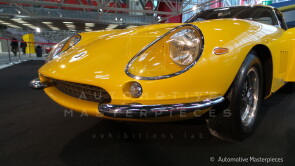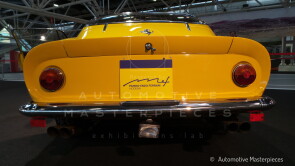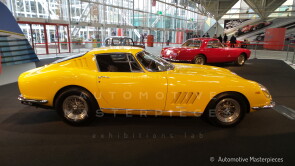
1967 Ferrari 275 GTB4
ON/OFF
Why am I an Automotive Masterpiece?
The Ferrari 275 GTB is a Berlinetta produced by the Italian manufacturer Ferrari (hence the “B” in the acronym) and was first presented in 1964 at the Paris Motor Show, alongside the spider version known as the Ferrari 275 GTS. The GTB featured taut, slender lines with styling cues inspired by the racing world, such as the distinctive side air vents, truncated tail, and faired headlights. At the request of Luigi Chinetti’s NART (North American Racing Team), ten spider-bodied cars were built between 1966 and 1967, featuring identical bodywork to the GTB/4 Berlinetta—with the obvious exception of the convertible soft top. These were known as the 275 GTB/4 Spider N.A.R.T. A racing version, the 275 GTB/C “Competizione,” was also developed. The 275 GTB was introduced as the successor to the Ferrari 250 series and introduced numerous technical innovations. It was the first Ferrari grand tourer to adopt independent suspension on all four wheels and a 5-speed gearbox. The twin overhead camshaft (DOHC) setup was introduced on the final variants of the model. These important technical advancements were, in part, a response to the newly launched Lamborghini, which had introduced similar features to the grand touring segment with its 350 GTV. The styling was by Pininfarina, who designed a sleek, aerodynamic coupé body mounted on a frame with oval-section tubular side members and diagonal tubular reinforcements. The car featured a long bonnet, accentuating the Maranello-built V12 engine, which benefitted from improved cooling thanks to a larger front grille and four louvers on the front fenders. The headlights were faired, and the cockpit was set far back, while the rear end featured a pronounced spoiler, enhancing the aerodynamic effect of the truncated tail. Three additional louvers on the rear pillars vented hot air from the passenger compartment. The berlinettas were assembled by Carrozzeria Scaglietti in Modena and could be ordered either with a steel body and aluminum opening panels, or as a full aluminum-bodied version. Mechanically, the car retained the V12 alloy engine designed by Gioachino Colombo, with an enlarged bore to achieve a unitary displacement of 275 cc, for a total displacement of approximately 3.3 liters. The engine could be fitted with three twin-choke Weber carburetors (producing 280 hp at 7600 rpm) or six twin-choke Webers (raising output to 300 hp at 7500 rpm). The 275 GTB was both the last Ferrari model with single overhead camshaft (SOHC) and the first with twin overhead camshafts (DOHC) in the GTB/4 version introduced in 1966. The chassis was a spaceframe made of special steel tubes, and the suspension consisted of independent double wishbones at all four corners, with front and rear anti-roll bars. Braking was provided by Dunlop disc brakes on all four wheels, equipped with a brake booster. Perhaps the most significant innovation was the new 5-speed gearbox, entirely built in-house by Ferrari and mounted at the rear in a transaxle configuration, integrated with the differential. The steering system used a worm and roller mechanism. The car came with light alloy wheels by default, although 15-inch Borrani wire wheels were available as an option. All these features made the car agile and fast. However, its performance was somewhat penalized by its weight and by the undersized brake discs, which were prone to fading under hard use.
At the 1966 Paris Auto Salon, Ferrari unveiled the 275 GTB/4, equipped with the new four-cam Tipo 226 engine. This marked a significant evolution of a sports car that already featured independent suspension on all four wheels, disc brakes, and a 3.3-liter V12—the final development of the Colombo-designed “short-block” engine. With its six Weber carburetors, the engine again produced around 300 horsepower, but now with a livelier response at higher revs. As before, the Ferrari 275 GTB/4’s stunning bodywork was designed by Pininfarina and built by Scaglietti. While it appeared identical to the long-nose (second series) 275 GTB, it could be distinguished by the pronounced bulge on the hood, necessary to accommodate the new engine configuration. The GTB/4 benefitted from a variety of upgrades derived from the competition versions of the 275, which had proven themselves in racing. The “4” in GTB/4 referred to the engine’s four overhead camshafts—two per cylinder bank—making it the first quad-cam road-going Ferrari ever produced. During its production run, which lasted until 1968, only 320 examples of the 275 GTB/4 were built.
This very car, chassis no. 09573, is one of the 320 four-cam 275 GTBs. Finished in its stunning "Giallo Fly"—the iconic Ferrari yellow—it has a private, grand touring history. Today, it is preserved at the Museo Ferrari itself.




